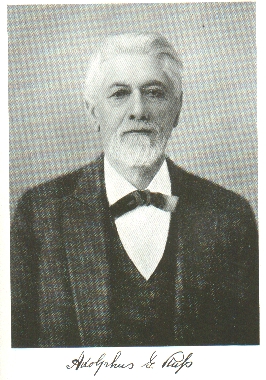
ADOLPHUS GUSTAVE RUSS
Adolphus
Gustave Russ. Closely connected with the early development of San
Francisco is the family bearing the name of Russ, whose representatives, father
and sons, were men of unblemished character and excellent business judgment,
whose energy and means were used in the establishing and carrying on of
different enterprises, and whose talents were given in civic service when
needed. The head of the family was Charles Christian Russ, who was born
in Heidelberg-Hausen, Saxony, Germany, in 1795, and died in San Francisco, June
4, 1857. His son, Adolphus Gustave Russ, who was also born in Germany,
succeeded his father in his undertakings, and became one of the leading
business men of San Francisco, but he, too, has long since passed to his reward
in another world.
Charles Christian Russ was a silversmith by trade, who, in 1832, brought his
family to the United States and established himself in his vocation at New York
City. His children had all been reared to habits of industry and thrift,
and they, with him, worked hard for the good of the family, and were so
successful that by 1845 they had accumulated $20,000, then a fortune.
While attending the funeral of Gen. Andrew Jackson, thieves entered their
establishment and robbed them of everything they possessed.
In the meanwhile the attention of the elder Mr. Russ had been attracted to the coast by the letters of Captain Sutler and others, and therefore, after meeting with his great loss he began to think seriously of seeking new opportunities in California.
War had been declared with Mexico by the United States Government. Mr.
Russ had, as did all of his fellow countrymen, given his compulsory military
service and understood military matters, so he entered the regiment Colonel
Stevenson was organizing, as a private, and his eldest son, Adolphus Gustave,
was also accepted as a private, and the next two sons, Charles Edward and
Augustus, as drummer and fifer. They all embarked on the boat Loo Choo
and arrived in San Francisco in March 1847.
Mr. Russ bought lumber and erected himself a home on the banks, and entered the
jewelry business,and his son, Adolphus Gustave, was of great assistance
to him in conducting it. After the discovery of gold, the merchants of
California were at first afraid of the specimens the miners brought in, fearing
they were not genuine, but Mr. Russ made an assay, and upon his report the
merchants, at a meeting, declared that they would pay fourteen dollars in trade
or ten dollars case for each ounce of the dust.
The Russ family remained together and pooled their interests, so that they
prospered from the start. After the death of the father the eldest son,
Adolphus Gustave, took his place, and the Russ family erected thirty-five
buildings and the old Russ House and the famous old American House. In
1852 the Russ family opened the famous Russ Garden, which for many years was
the only suburban place for picnics and similar outings. The mother of
the Russ family died February 15, 1880. In addition to Adolphus Gustave
their children were as follows: Charles Edward, who spent the greater
part of his life with his family; Augustus Philip who was a world traveler;
Frederick, who was also an extensive traveler; and Henry B., who was born after
the Russ family reached New York.
Adolphus Gustave Russ first worked for a time in the mines after coming to
California, but soon joined his father and brothers at San Francisco, and with
them prospered. He married Frances Simon, and they became the parents of
the following children: Lillie, who married Kurt Bruckman, and they have
two children, Grace, who married E. L. Chloupek, has a daughter, Lily, Viola
B., who married Harry Koster, has two children, Viola and John; and Laura B.,
who married Henry W. Westphal,has one son, Adolph Russ.
Transcribed
by Marilyn R. Pankey.
Source: "The San
Francisco Bay Region" by Bailey Millard Vol. 3 page 122-125. Published by The
American Historical Society, Inc. 1924.